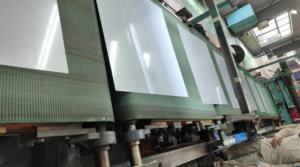The steel industry is a pillar industry of the national economy, and it is also a high-emission and high-pollution industry. As people’s awareness of environmental protection increases, the environmental indicators of steel production are also constantly improving. In particular, a series of environmental protection issues that arise during the production of high-speed steel need to be addressed urgently. This article will detail the environmental issues during high-speed steel production.

Environmental Issues During High-speed Steel Production:
Firstly, there is air pollution. In the production of high-speed steel, the electroslag remelting technology is frequently employed, which, while effective in reducing sulfur and phosphorus content in the steel liquid and enhancing its purity, generates substantial amounts of harmful substances such as fluorides, sulfides, and dust. If these pollutants are not adequately controlled, they can not only contaminate the air but also pose health risks to humans. Therefore, it is imperative to implement dust removal, desulfurization, and denitrification treatments for the exhaust gases generated during high-speed steel production.
Secondly, there is water pollution. The production process of high-speed steel encompasses multiple stages, including cooling, washing, descaling, and derusting, which consume vast amounts of water resources. This water often contains hazardous substances like heavy metals, acids, and alkalis. Direct discharge of this wastewater into rivers and lakes can lead to the degradation of water resources. Consequently, the wastewater generated from high-speed steel production must undergo purification treatment before discharge.
Furthermore, there is soil pollution. The production process also yields significant amounts of waste slag, which often contains hazardous substances such as heavy metals and polycyclic aromatic hydrocarbons. When discharged into the soil, these pollutants can not only deteriorate soil quality but also enter the human body through the food chain, posing health risks. Therefore, it is necessary to sort and treat the waste slag generated during high-speed steel production.
Additionally, noise pollution is another co
Additionally, noise pollution is another concern. High-speed steel production involves extensive mechanical operations, such as rolling mills and shearing machines, which generate substantial noise. This noise can significantly disturb and harm nearby residents and wildlife. To mitigate noise pollution, efforts should be made to strengthen the maintenance and inspection of steel production equipment to reduce vibration and impact, thereby lessening the adverse effects of noise pollution.
Conclusion
In conclusion, the production of high-speed steel has a pronounced impact on the environment. To reduce environmental pollution, it is essential to adopt more advanced production processes and technologies, enhance energy efficiency, and minimize waste generation. Simultaneously, a robust environmental management system should be established to strengthen supervision and management of the high-speed steel production process.
Why Choose Sino Special Metal?
Thank you for reading our article and we hope it can help you to have a better understanding of the environmental issues during high-speed steel production. If you are looking for high-speed steel suppliers and manufacturers online now, we would advise you to visit Sino Special Metal.
As a leading supplier of high-speed steel from Shanghai China, Sino Special Metal offers customers high-quality M2 High-Speed Steel, M35 High-Speed Steel, and M42 High-Speed Steel at a very competitive price.




